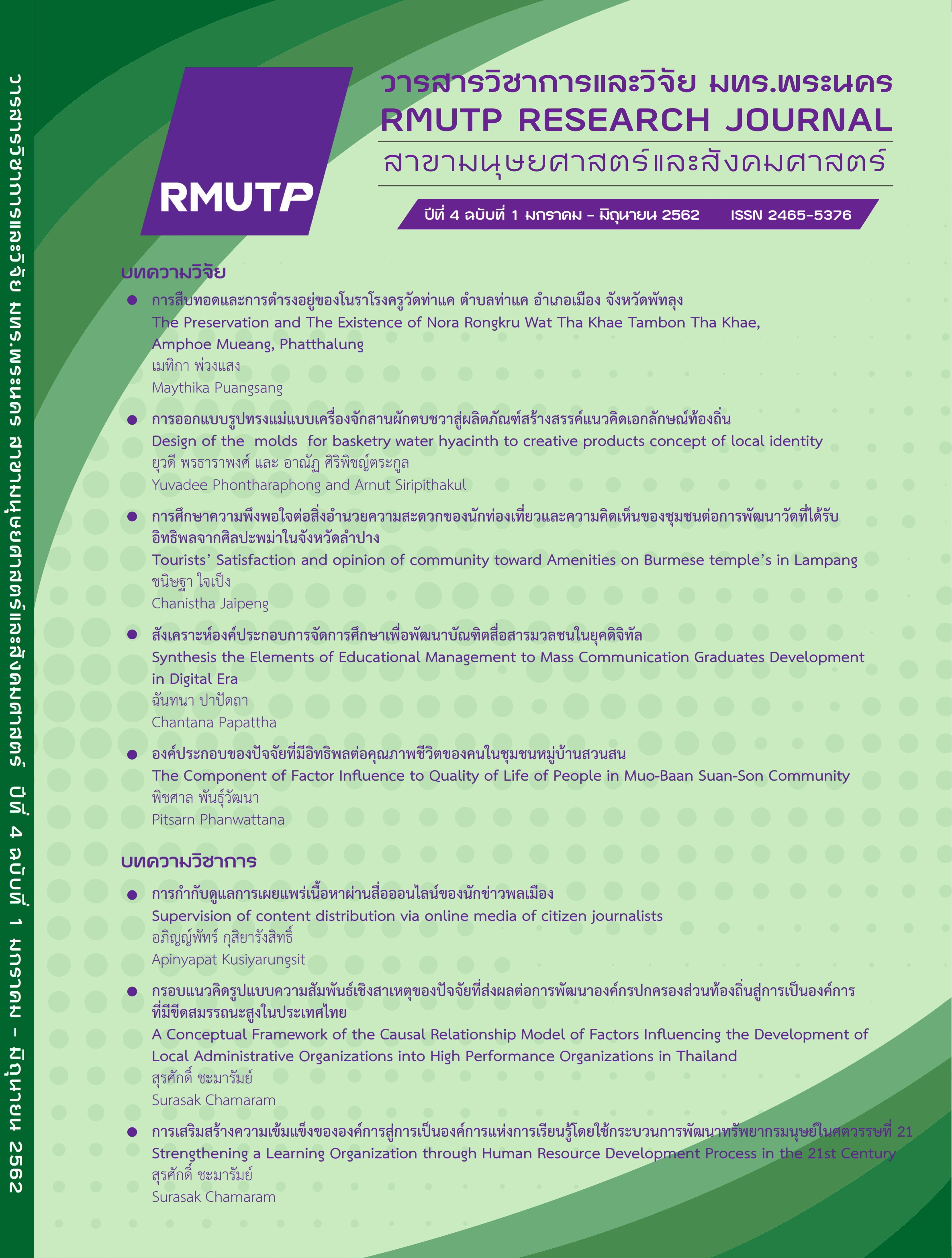The Potential of Historical tourism: A case study of Burmese temple’s in Lampang
Main Article Content
Abstract
Historical tourism is important for various reasons; it has a positive economic and social impact, it establishes and reinforces identity, it helps build image, it helps preserve the cultural and historical heritage, with culture as an instrument it facilitates harmony and understanding among people, it supports culture and helps renew tourism. This research aims to 1. Study the Potential of Historical tourism only the temples influenced by Burmese appear in temples in Lampang and 2. Study the tourist routes linked to promote historical tourism in Lampang. The research population is 280 people by interviews and surveys. Research conducted between January 2017 to June 2017.
The research found that The most popular tourist destinations are Wat Pa Fang, Wat Si Chum, Wat Si Rongmuang, Wat Mon Poo Yak , Wat Mon Cham Sin, Wat Tha Ma O Wat Chai Mongkol (Temple of Wat) is a measure of importance. Has a long history Value for conservation .The art of faith, religion, history. It has not been well managed and has the potential to provide a total of seven trails for historical tourism. It cannot be linked to other forms of tourism. However, after the Tourism Authority of Thailand launch campaign of 12 cities you Can’t Say No. Lampang is one of the provinces in the project. Lampang and the Tourism Authority of Thailand are expected to discuss and organize historic tours in the historic city for future sustainability.
Article Details
References
ชัยธวัช ทองอินทร์. (2549). กระบวนทัศน์ของการจัดการโลจิสติกส์สำหรับอุตสาหกรรมการ ท่องเที่ยวไทย. [ออนไลน์]. ได้จาก: http://www.siamzip.com/tlog/components/com_booklibrary/ebooks /C09.pdf สืบค้นเมื่อวันที่ 9 มีนาคม 2560.
จารุจน์ กลิ่นดีปลี. (2541).การประเมินศักยภาพของแหล่งท่องเที่ยวสำหรับการท่องเที่ยวเชิงนิเวศกรณีศึกษา: อุทยานแห่งชาติไทรโยค จังหวัดกาญจนบุรี. ภาคนิพนธ์หลักสูตรการจัดการสิ่งแวดล้อม สำนักพัฒนาบัณฑิตศึกษา สถาบันบัณฑิตพัฒนบริหารศาสตร์.
นิฐริน ไล้พันธ์ . (2544). ศักยภาพและแนวทางการพัฒนาการท่องเที่ยวเชิงนิเวศ อุทยานแห่งชาติภูจองนายอย จังหวัดอุบลราชธานี . สาขาวิชาการจัดการมนุษย์กับสิ่งแวดล้อม บัณฑิตวิทยาลัยมหาวิทยาลัยเชียงใหม่.
วิวัฒน์ชัย บุญยภักดิ์. (2550). ทรัพยากรการท่องเที่ยวของไทย. ใน เอกสารการสอนชุดวิชาทรัพยากรการท่องเที่ยวของไทยสาขาวิชาวิทยาการจัดการ มหาวิทยาลัยสุโขทัยธรรมาธิราช, 286. นนทบุรี : มหาวิทยาลัยสุโขทัยธรรมาธิราช.
องค์การบริหารการพัฒนาพื้นที่พิเศษเพื่อการท่องเที่ยวอย่างยั่งยืน (องค์การมหาชน).(มปป.).ระบบออนไลน์. ท่องเที่ยวเชิงประวัติศาสตร์ หนึ่งในรูปแบบการท่องเที่ยวอย่างยั่งยืนที่น่าสนใจ. สืบค้นจากhttp://www.dasta.or.th/th(สืบค้นวันที่ 3 กุมภาพันธ์ 2560)
Collier, Alan and Harraway,Sue. (1987). The New Zealand Tourism Industry. Auckland: Longman
Tourism Western Australia. (2008). Five A’s of Tourism. Retrieved October 25, 2012, from http://www.tourism.wa.gov.au/jumpstartguide/pdf/Quickstart_five%20A's%20of%20TourismLOW.pdf. (สืบค้นวันที่ 3 กุมภาพันธ์ 2560)


